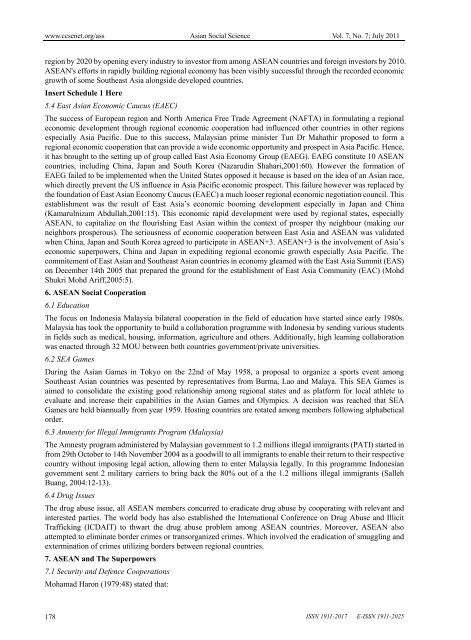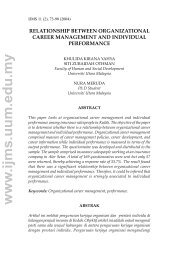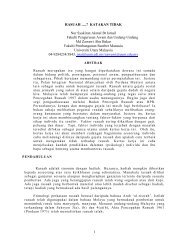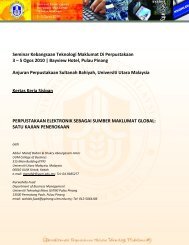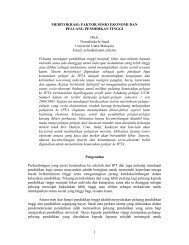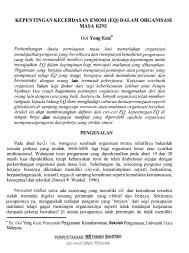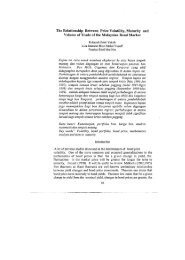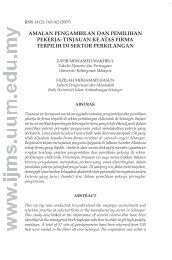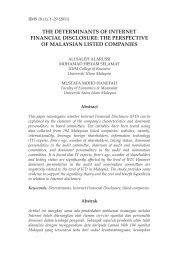The Development of ASEAN from Historical Approach
The Development of ASEAN from Historical Approach
The Development of ASEAN from Historical Approach
You also want an ePaper? Increase the reach of your titles
YUMPU automatically turns print PDFs into web optimized ePapers that Google loves.
www.ccsenet.org/ass Asian Social Science Vol. 7, No. 7; July 2011<br />
region by 2020 by opening every industry to investor <strong>from</strong> among <strong>ASEAN</strong> countries and foreign investors by 2010.<br />
<strong>ASEAN</strong>'s efforts in rapidly building regional economy has been visibly successful through the recorded economic<br />
growth <strong>of</strong> some Southeast Asia alongside developed countries.<br />
Insert Schedule 1 Here<br />
5.4 East Asian Economic Caucus (EAEC)<br />
<strong>The</strong> success <strong>of</strong> European region and North America Free Trade Agreement (NAFTA) in formulating a regional<br />
economic development through regional economic cooperation had influenced other countries in other regions<br />
especially Asia Pacific. Due to this success, Malaysian prime minister Tun Dr Mahathir proposed to form a<br />
regional economic cooperation that can provide a wide economic opportunity and prospect in Asia Pacific. Hence,<br />
it has brought to the setting up <strong>of</strong> group called East Asia Economy Group (EAEG). EAEG constitute 10 <strong>ASEAN</strong><br />
countries, including China, Japan and South Korea (Nazarudin Shahari,2001:60). However the formation <strong>of</strong><br />
EAEG failed to be implemented when the United States opposed it because is based on the idea <strong>of</strong> an Asian race,<br />
which directly prevent the US influence in Asia Pacific economic prospect. This failure however was replaced by<br />
the foundation <strong>of</strong> East Asian Economy Caucus (EAEC) a much looser regional economic negotiation council. This<br />
establishment was the result <strong>of</strong> East Asia’s economic booming development especially in Japan and China<br />
(Kamarulnizam Abdullah,2001:15). This economic rapid development were used by regional states, especially<br />
<strong>ASEAN</strong>, to capitalize on the flourishing East Asian within the context <strong>of</strong> prosper thy neighbour (making our<br />
neighbors prosperous). <strong>The</strong> seriousness <strong>of</strong> economic cooperation between East Asia and <strong>ASEAN</strong> was validated<br />
when China, Japan and South Korea agreed to participate in <strong>ASEAN</strong>+3. <strong>ASEAN</strong>+3 is the involvement <strong>of</strong> Asia’s<br />
economic superpowers, China and Japan in expediting regional economic growth especially Asia Pacific. <strong>The</strong><br />
commitement <strong>of</strong> East Asian and Southeast Asian countries in economy gleamed with the East Asia Summit (EAS)<br />
on December 14th 2005 that prepared the ground for the establishment <strong>of</strong> East Asia Community (EAC) (Mohd<br />
Shukri Mohd Ariff,2005:5).<br />
6. <strong>ASEAN</strong> Social Cooperation<br />
6.1 Education<br />
<strong>The</strong> focus on Indonesia Malaysia bilateral cooperation in the field <strong>of</strong> education have started since early 1980s.<br />
Malaysia has took the opportunity to build a collaboration programme with Indonesia by sending various students<br />
in fields such as medical, housing, information, agriculture and others. Additionally, high learning collaboration<br />
was enacted through 32 MOU between both countries government/private universities.<br />
6.2 SEA Games<br />
During the Asian Games in Tokyo on the 22nd <strong>of</strong> May 1958, a proposal to organize a sports event among<br />
Southeast Asian countries was pesented by representatives <strong>from</strong> Burma, Lao and Malaya. This SEA Games is<br />
aimed to consolidate the existing good relationship among regional states and as platform for local athlete to<br />
evaluate and increase their capabilities in the Asian Games and Olympics. A decision was reached that SEA<br />
Games are held biannually <strong>from</strong> year 1959. Hosting countries are rotated among members following alphabetical<br />
order.<br />
6.3 Amnesty for Illegal Immigrants Program (Malaysia)<br />
<strong>The</strong> Amnesty program administered by Malaysian government to 1.2 millions illegal immigrants (PATI) started in<br />
<strong>from</strong> 29th October to 14th November 2004 as a goodwill to all immigrants to enable their return to their respective<br />
country without imposing legal action, allowing them to enter Malaysia legally. In this programme Indonesian<br />
government sent 2 military carriers to bring back the 80% out <strong>of</strong> a the 1.2 millions illegal immigrants (Salleh<br />
Buang, 2004:12-13).<br />
6.4 Drug Issues<br />
<strong>The</strong> drug abuse issue, all <strong>ASEAN</strong> members concurred to eradicate drug abuse by cooperating with relevant and<br />
interested parties. <strong>The</strong> world body has also established the International Conference on Drug Abuse and Illicit<br />
Trafficking (ICDAIT) to thwart the drug abuse problem among <strong>ASEAN</strong> countries. Moreover, <strong>ASEAN</strong> also<br />
attempted to eliminate border crimes or transorganized crimes. Which involved the eradication <strong>of</strong> smuggling and<br />
extermination <strong>of</strong> crimes utilizing borders between regional countries.<br />
7. <strong>ASEAN</strong> and <strong>The</strong> Superpowers<br />
7.1 Security and Defence Cooperations<br />
Mohamad Haron (1979:48) stated that:<br />
178<br />
ISSN 1911-2017 E-ISSN 1911-2025


